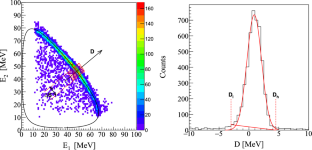Dynamics of Three-Nucleon Systems at 100 MeV
IF 1.7
4区 物理与天体物理
Q2 PHYSICS, MULTIDISCIPLINARY
引用次数: 0
Abstract
Differential cross section for the \(^1\)H(d,pp)n deuteron breakup reaction is sensitive to dynamical ingredients such as three-nucleon force or Coulomb force and allows for thorough tests of theoretical potential models describing the interaction in the three nucleon systems. The analysis of the experimental data collected for the breakup reaction at the beam energy of 100 MeV has been performed and the cross section results for selected configurations are presented. They are in good agreement with calculations based on the realistic potentials and state-of-the-art calculations within the Chiral Effective Field Theory framework.

100 兆电子伏下的三核子系统动力学
(^1\)H(d,pp)n氘核破裂反应的差分截面对三核力或库仑力等动力学成分很敏感,可以对描述三核子系统中相互作用的理论势能模型进行彻底测试。我们对在 100 兆电子伏特束能下收集到的破裂反应实验数据进行了分析,并给出了选定构型的截面结果。这些结果与基于现实电势的计算结果以及手性有效场理论框架内的最新计算结果非常吻合。
本文章由计算机程序翻译,如有差异,请以英文原文为准。
求助全文
约1分钟内获得全文
求助全文
来源期刊

Few-Body Systems
物理-物理:综合
CiteScore
2.90
自引率
18.80%
发文量
64
审稿时长
6-12 weeks
期刊介绍:
The journal Few-Body Systems presents original research work – experimental, theoretical and computational – investigating the behavior of any classical or quantum system consisting of a small number of well-defined constituent structures. The focus is on the research methods, properties, and results characteristic of few-body systems. Examples of few-body systems range from few-quark states, light nuclear and hadronic systems; few-electron atomic systems and small molecules; and specific systems in condensed matter and surface physics (such as quantum dots and highly correlated trapped systems), up to and including large-scale celestial structures.
Systems for which an equivalent one-body description is available or can be designed, and large systems for which specific many-body methods are needed are outside the scope of the journal.
The journal is devoted to the publication of all aspects of few-body systems research and applications. While concentrating on few-body systems well-suited to rigorous solutions, the journal also encourages interdisciplinary contributions that foster common approaches and insights, introduce and benchmark the use of novel tools (e.g. machine learning) and develop relevant applications (e.g. few-body aspects in quantum technologies).
 求助内容:
求助内容: 应助结果提醒方式:
应助结果提醒方式:


